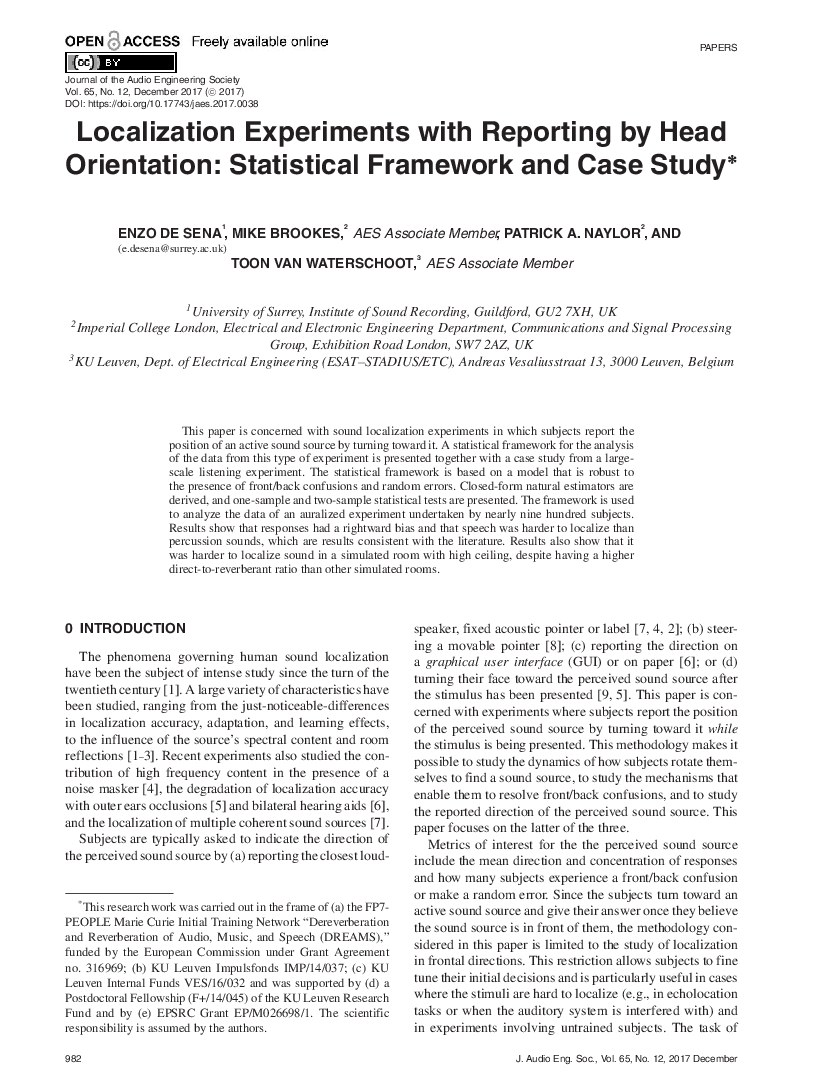Home / Publications / E-library page
You are currently logged in as an
Institutional Subscriber.
If you would like to logout,
please click on the button below.
Home / Publications / E-library page
Only AES members and Institutional Journal Subscribers can download
This research focuses on sound localization experiments in which subjects report the position of an active sound source by turning toward it. A statistical framework for the analysis of the data is presented together with a case study from a large-scale listening experiment. The statistical framework is based on a model that is robust to the presence of front/back confusions and random errors. Closed-form natural estimators are derived, and one-sample and two-sample statistical tests are described. The framework is used to analyze the data of an auralized experiment undertaken by nearly nine hundred subjects. The objective was to explore localization performance in the horizontal plane in an informal setting and with little training, which are conditions that are similar to those typically encountered in consumer applications of binaural audio. Results show that responses had a rightward bias and that speech was harder to localize than percussion sounds, which are results consistent with the literature. Results also show that it was harder to localize sound in a simulated room with a high ceiling despite having a higher direct-to-reverberant ratio than other simulated rooms.
Author (s): Sena, Enzo De; Brookes, Mike; Naylor, Patrick A.; Waterschoot, Toon van
Affiliation:
University of Surrey, Institute of Sound Recording, Guildford, UK; Imperial College London, Electrical and Electronic Engineering Department, Communications and Signal Processing Group, London, UK; KU Leuven, Dept. of Electrical Engineering (ESAT-STADIUS/ETC), Leuven, Belgium
(See document for exact affiliation information.)
Publication Date:
2017-12-06
Import into BibTeX
Permalink: https://aes2.org/publications/elibrary-page/?id=19364
(750KB)
Click to purchase paper as a non-member or login as an AES member. If your company or school subscribes to the E-Library then switch to the institutional version. If you are not an AES member Join the AES. If you need to check your member status, login to the Member Portal.

Sena, Enzo De; Brookes, Mike; Naylor, Patrick A.; Waterschoot, Toon van; 2017; Localization Experiments with Reporting by Head Orientation: Statistical Framework and Case Study [PDF]; University of Surrey, Institute of Sound Recording, Guildford, UK; Imperial College London, Electrical and Electronic Engineering Department, Communications and Signal Processing Group, London, UK; KU Leuven, Dept. of Electrical Engineering (ESAT-STADIUS/ETC), Leuven, Belgium; Paper ; Available from: https://aes2.org/publications/elibrary-page/?id=19364
Sena, Enzo De; Brookes, Mike; Naylor, Patrick A.; Waterschoot, Toon van; Localization Experiments with Reporting by Head Orientation: Statistical Framework and Case Study [PDF]; University of Surrey, Institute of Sound Recording, Guildford, UK; Imperial College London, Electrical and Electronic Engineering Department, Communications and Signal Processing Group, London, UK; KU Leuven, Dept. of Electrical Engineering (ESAT-STADIUS/ETC), Leuven, Belgium; Paper ; 2017 Available: https://aes2.org/publications/elibrary-page/?id=19364
@article{sena2017localization,
author={sena enzo de and brookes mike and naylor patrick a. and waterschoot toon van},
journal={journal of the audio engineering society},
title={localization experiments with reporting by head orientation: statistical framework and case study},
year={2017},
volume={65},
issue={12},
pages={982-996},
month={december},}
TY – paper
TI – Localization Experiments with Reporting by Head Orientation: Statistical Framework and Case Study
SP – 982 EP – 996
AU – Sena, Enzo De
AU – Brookes, Mike
AU – Naylor, Patrick A.
AU – Waterschoot, Toon van
PY – 2017
JO – Journal of the Audio Engineering Society
VO – 65
IS – 12
Y1 – December 2017